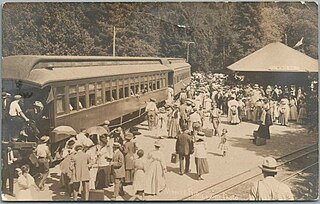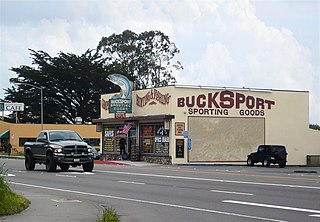History
John Vance built a sawmill near the Mad River community of Essex, in 1875, with a railroad to transport lumber from the sawmill to Mad River Slough on Humboldt Bay for loading onto ships. This Humboldt and Mad River Railroad had three locomotives and connected with paddle-wheel steamboats from Eureka, California, at Mad River Slough. Vance constructed a new sawmill in Samoa, California, in 1893, and extended his railroad both north and south to bring logs from Lindsay Creek to the Samoa sawmill. The railroad was incorporated as the Eureka and Klamath River Railroad in 1896. Andrew Hammond purchased the railroad and sawmill on 30 August 1900. [2]
The 36-mile (58 km) Oregon and Eureka Railroad formed through Hammond's 1903 agreement with Southern Pacific was equipped with seven locomotives, two 48-foot (15 m) passenger coaches, and 166 freight cars. The railroad had 212 freight cars by 1905, and was extended in 1906 to carry lumber from the Little River Redwood Company sawmill at Crannell, California. The Oregon and Eureka was included in the Northwestern Pacific Railroad (NWP) merger on 8 January 1907, and extended to Trinidad, California on 22 June. [2]
Northwestern Pacific trains began operating to Trinidad on 1 July 1911. Hammond Lumber Company was formed in 1912 using some of the Oregon and Eureka rolling stock on logging branches off the former Oregon and Eureka main line. Hammond merged with the Little River Redwood Company on 24 February 1931. Northwestern Pacific ended service to Trinidad on 1 March 1933; and dismantled the line between Korblex and Little River Junction. The southern end of the line linked the Samoa mill complex to the national rail network for another half century. NWP sold the line north of Little River Junction back to Hammond Lumber Company. Hammond extended logging branches northward toward Big Lagoon until a 1945 wildfire destroyed many of the trestles. The last logging train ran on 23 August 1948. [2]

The “Northwestern Pacific Railroad” was a 271 mile mainline railroad from the ferry connections in Sausalito north to Eureka with a connection to the national railroad system at Schellville. The railroad has gone through a history of different ownership and operators but has maintained a generic name of reference as “The Northwestern Pacific.” Currently, only a 62-mile (100 km) stretch of mainline on the “South End” is operated by Sonoma-Marin Area Rail Transit (SMART), which operates both commuter and freight trains with plans for future extension north to Cloverdale. The “North End,” from Willits to Eureka which includes connections to the California Western Railroad] is currently out of service but saved by 2018 legislation to be converted into the Great Redwood Trail.

The Arcata and Mad River Railroad, founded in 1854, was the oldest working railroad in California. It operated on a unique narrow gauge until the 1940s when standard gauge rails were laid. Service ceased in 1983 due to landslides. It is California Historical Landmark #842.

Andrew Benoni Hammond was an American lumberman. He developed the Missoula Mercantile Co. He built the Bitterroot Valley Railroad and the Astoria & Columbia River Railroad. He was president of the Hammond Lumber Co. and the Hammond Steamship Co.
The Pacific Lumber Company, officially abbreviated PALCO, and also commonly known as PL, was one of California's major logging and sawmill operations, located 28 miles (45 km) south of Eureka and 244 miles (393 km) north of San Francisco. Begun in 1863, PALCO was managed over most of the twentieth century by generations of the Simon J. Murphy, Sr. Family or managers chosen by the Murphys from 1905 through 1985. Primary operations existed in massive log storage and milling operations at the historic company town of Scotia, California, located adjacent to US 101 along the Eel River. Secondary mills were located in nearby Fortuna and Carlotta. PALCO had extensive timber holdings exceeding well over 200,000 acres (890 km²) in the Redwood and Douglas-Fir forests of Humboldt County. For generations, it was one of the largest private employers in the entire region, appropriately known as the Redwood Empire.

The Albion River is an 18.1-mile-long (29.1 km) river in Mendocino County, California. The river drains about 43 square miles (110 km2) on the Mendocino Coast and empties into the Pacific Ocean near the town of Albion, California, where California State Route 1 crosses it on the Albion River Bridge. The river's overall direction is east to west, but it moves significantly in the north-south direction. The tributaries of the river include Railroad Gulch, Pleasant Valley Creek, Duck Pond Gulch, South Fork Albion River, Tom Bell Creek, North Fork Albion River, and Marsh Creek. The river's most inland point is only 15 miles (24 km) from the coast, and its highest elevation is about 1,570 feet (480 m) above sea level. There is a large estuary at the mouth of the river, and tidal waters travel up to 5 miles (8 km) upstream. The Albion River was previously used to power a sawmill on the river mouth, but there are no major dams or reservoirs on the river. The river provides recreation, groundwater recharge and industrial water supply for the community of Albion, and wildlife habitat including cold freshwater habitat for fish migration and spawning.

The Oregon, Pacific and Eastern Railway was an Oregon-based short line railroad that began near Eugene as the Oregon and Southeastern Railroad (O&SE) in 1904. O&SE's line ran 18 miles (29 km) along the Row River between the towns of Cottage Grove and Disston. The Oregon, Pacific & Eastern Railway Company incorporated in 1912, purchased the physical assets of the O&SE two years later, and shortened their total trackage to operate 16.6 miles (26.7 km) from an interchange yard with the Southern Pacific Railroad at Cottage Grove, east to a 528' x 156' turnaround loop at Culp Creek. The last of this track was closed and scrapped in 1994, and ownership of its abandoned right of way property was later reverted to the state of Oregon to become one of the first-ever Government/Private Sector cooperative partnership Rails to Trails programs in the US, forming the Row River National Recreation Trail. A successor corporation now operates a narrow-gauge line at Wildlife Safari.

The North Pacific Coast Railroad (NPC) was a common carrier 3 ft (914 mm) narrow-gauge steam railroad begun in 1874 and sold in 1902 to new owners who renamed it the North Shore Railroad (California) (NSR) and which rebuilt the southern section into a standard-gauge electric railway.

Scotia, formerly known as Forestville until 1888, is a census-designated place in Humboldt County, California. It is located on the Eel River along U.S. Route 101, 8.5 miles (13.7 km) southeast of Fortuna and 244 miles (393 km) north of San Francisco. Scotia has a population of 850.

Samoa is a census-designated place in Humboldt County, California. It is located 1.5 miles (2.4 km) northwest of Eureka, at an elevation of 23 feet. Samoa is located in the northern peninsula of Humboldt Bay and is the site of the Samoa Cookhouse, one of the last remaining original, lumber-camp style cookhouses. The name Samoa is used interchangeably with the peninsula it occupies. The population was 258 at the 2010 census.

Alton is an unincorporated community in Humboldt County, California. It is located 3.5 miles (5.6 km) south-southeast of Fortuna, at an elevation of 62 feet. Alton is located along U.S. Route 101 and State Route 36. The ZIP Code is 95540. The community is inside area code 707.

San Francisco and North Pacific Railroad (SF&NP) provided the first extensive standard gauge rail service to Sonoma County and became the southern end of the regional Northwestern Pacific Railroad. Although first conceived of by Asbury Harpending, who had even obtained many of the right of ways, the SF & NP was bought and subsequently constructed by Peter Donahue, who drove the first spike on August 30, 1869.

San Francisco and Northwestern Railway (SF&NW) was an Atchison, Topeka and Santa Fe Railway subsidiary formed in 1903 to connect Humboldt Bay to the Santa Fe rail system.

Bucksport was a town in Humboldt County, California. The original location was 2.5 miles (4 km) southwest of downtown Eureka, on Humboldt Bay about 5 miles (8 km) northeast of entrance. at an elevation of 16 feet (4.9 m). Prior to American settlement a Wiyot village named Kucuwalik stood here.

The Fort Bragg and Southeastern Railroad was formed by Atchison, Topeka and Santa Fe Railway as a consolidation of logging railways extending inland from Albion, California on the coast of Mendocino County. The railroad and its predecessors operated from August 1, 1885 to January 16, 1930. The line was merged into the regional Northwestern Pacific Railroad in 1907; but planned physical connection was never completed.

The Eel River and Eureka Railroad company was organized on November 14, 1882, by a group of Eureka businessmen led by John M. Vance. One of the other founders of the line was William Carson.
Hammond Lumber Company was a logging and resource extraction company operating in Humboldt County, CA.
Mendocino Lumber Company operated a sawmill on Big River near the town of Mendocino, California. The sawmill began operation in 1853 as the Redwood Lumber Manufacturing Company, and changed ownership several times before cutting its final logs in 1938. The sawmill site became part of the Big River Unit of Mendocino Headlands State Park where a few features of the mill and its associated forest railway are still visible along the longest undeveloped estuary in northern California.
The Hammond Trail is a northern California rail trail along the Pacific coast in Humboldt County. The 5.5 mi (8.9 km) hiking and biking trail follows the historic Hammond Lumber Company's Humboldt Northern Railway grade from the Mad River to Little River State Beach.
















